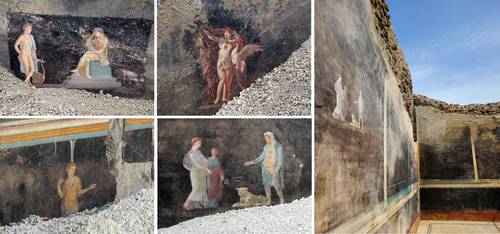Rome. Splendid frescoes inspired by the Trojan War that adorn a banquet hall were discovered in Pompeii, announced yesterday those in charge of the famous archaeological site located near Naples, in southern Italy.
This room of imposing dimensions (15 by 6 meters) presents refined decorations of mythological themes on black background walls and mosaics, which bear witness to the luxurious way of life reigning in the ancient city, buried under ashes in the year 79 by the eruption of Vesuvius.
The dominant theme of the fresco cycle is heroism, through representations of pairs of heroes and deities protagonists of the Trojan War.
But these paintings also evoke destiny and the ways in which humans can change it.
Among the characters represented are Paris and Helen, the Trojan prince who kidnapped the wife of the king of Sparta, Menelaus, which sparked the Trojan War.
You can also see Cassandra, sister of Paris, and the god Apollo, from whom he receives the gift of seeing the future, although his predictions were not believed even by his family.
Thus he warned his compatriots in vain that the horse offered by the Greeks was a subterfuge that would lead Troy to its doom.
The frequent presence of mythological figures on the frescoes in the reception rooms of Roman houses had precisely the social function of entertaining guests and diners, providing topics for conversation and reflection on the meaning of existence.
explains the address of Pompeii.
The walls were painted black to prevent traces of smoke from the oil lamps from being seen.
In this room They gathered for banquets after sunset. The light from the lamps gave the impression that the painted images were moving, especially after a few glasses of good wine.
the director of Pompeii, the Italian-German Gabriel Zuchtriegel, poetically points out.
Pompeii It never stops surprising us, because every time we dig we find something beautiful and meaningful.
the Minister of Culture Gennaro Sangiuliano is happy for his part.
The volcanic ash released 2,000 years ago by Vesuvius settled in most of the houses in Pompeii, allowing them to be preserved almost entirely, as well as many of the bodies of the 3,000 dead caused by the catastrophe.
Listed as a World Heritage Site by the United Nations Educational, Scientific and Cultural Organization, Pompeii, the second most visited tourist site in Italy after the Colosseum in Rome, occupies a total area of about 22 hectares, of which a third is still buried under ashes.
